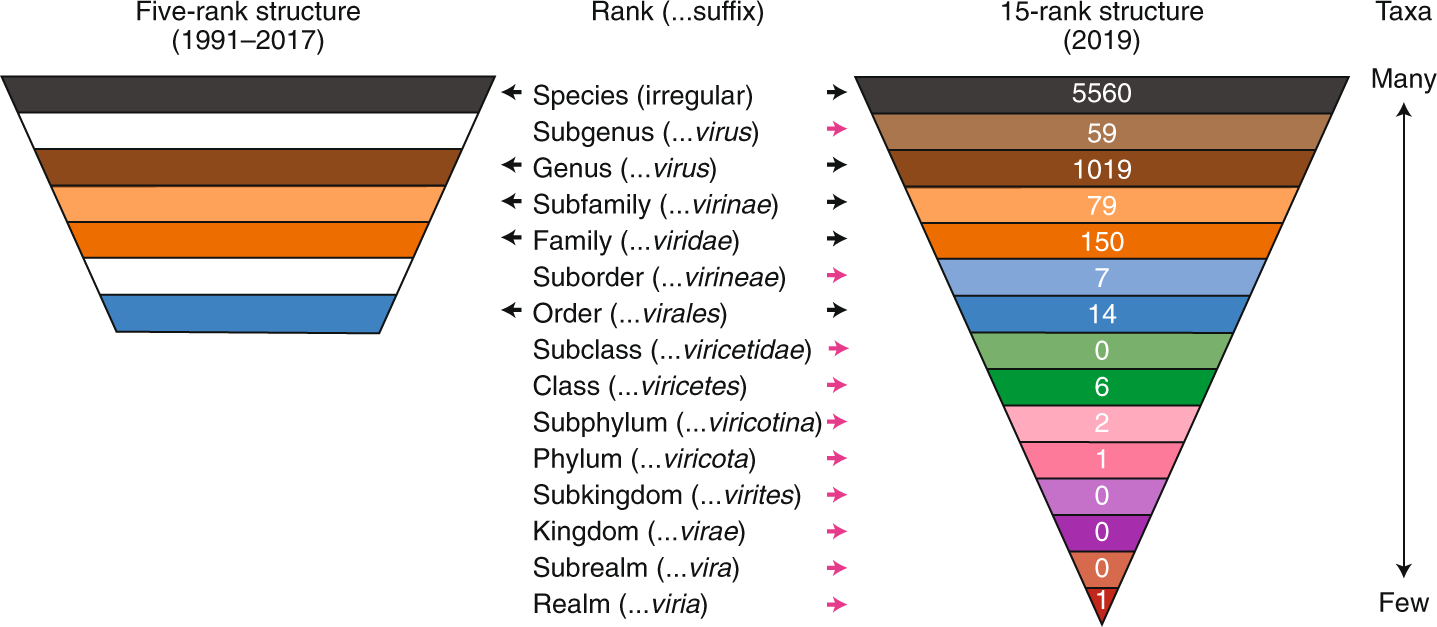doi.org/10.1038/s41564-020-0709-x
Preview meta tags from the doi.org website.
Linked Hostnames
26- 99 links todoi.org
- 50 links towww.ncbi.nlm.nih.gov
- 42 links toscholar.google.com
- 25 links towww.nature.com
- 7 links towww.springernature.com
- 4 links topartnerships.nature.com
- 3 links toauthorservices.springernature.com
- 3 links toictv.global
Thumbnail

Search Engine Appearance
The new scope of virus taxonomy: partitioning the virosphere into 15 hierarchical ranks - Nature Microbiology
Virus taxonomy emerged as a discipline in the middle of the twentieth century. Traditionally, classification by virus taxonomists has been focussed on the grouping of relatively closely related viruses. However, during the past few years, the International Committee on Taxonomy of Viruses (ICTV) has recognized that the taxonomy it develops can be usefully extended to include the basal evolutionary relationships among distantly related viruses. Consequently, the ICTV has changed its Code to allow a 15-rank classification hierarchy that closely aligns with the Linnaean taxonomic system and may accommodate the entire spectrum of genetic divergence in the virosphere. The current taxonomies of three human pathogens, Ebola virus, severe acute respiratory syndrome coronavirus and herpes simplex virus 1 are used to illustrate the impact of the expanded rank structure. This new rank hierarchy of virus taxonomy will stimulate further research on virus origins and evolution, and vice versa, and could promote crosstalk with the taxonomies of cellular organisms. Here, the International Committee on Taxonomy of Viruses describe a new, expanded virus classification scheme with 15 ranks that closely aligns with the Linnaean taxonomic system and better encompasses viral diversity.
Bing
The new scope of virus taxonomy: partitioning the virosphere into 15 hierarchical ranks - Nature Microbiology
Virus taxonomy emerged as a discipline in the middle of the twentieth century. Traditionally, classification by virus taxonomists has been focussed on the grouping of relatively closely related viruses. However, during the past few years, the International Committee on Taxonomy of Viruses (ICTV) has recognized that the taxonomy it develops can be usefully extended to include the basal evolutionary relationships among distantly related viruses. Consequently, the ICTV has changed its Code to allow a 15-rank classification hierarchy that closely aligns with the Linnaean taxonomic system and may accommodate the entire spectrum of genetic divergence in the virosphere. The current taxonomies of three human pathogens, Ebola virus, severe acute respiratory syndrome coronavirus and herpes simplex virus 1 are used to illustrate the impact of the expanded rank structure. This new rank hierarchy of virus taxonomy will stimulate further research on virus origins and evolution, and vice versa, and could promote crosstalk with the taxonomies of cellular organisms. Here, the International Committee on Taxonomy of Viruses describe a new, expanded virus classification scheme with 15 ranks that closely aligns with the Linnaean taxonomic system and better encompasses viral diversity.
DuckDuckGo
The new scope of virus taxonomy: partitioning the virosphere into 15 hierarchical ranks - Nature Microbiology
Virus taxonomy emerged as a discipline in the middle of the twentieth century. Traditionally, classification by virus taxonomists has been focussed on the grouping of relatively closely related viruses. However, during the past few years, the International Committee on Taxonomy of Viruses (ICTV) has recognized that the taxonomy it develops can be usefully extended to include the basal evolutionary relationships among distantly related viruses. Consequently, the ICTV has changed its Code to allow a 15-rank classification hierarchy that closely aligns with the Linnaean taxonomic system and may accommodate the entire spectrum of genetic divergence in the virosphere. The current taxonomies of three human pathogens, Ebola virus, severe acute respiratory syndrome coronavirus and herpes simplex virus 1 are used to illustrate the impact of the expanded rank structure. This new rank hierarchy of virus taxonomy will stimulate further research on virus origins and evolution, and vice versa, and could promote crosstalk with the taxonomies of cellular organisms. Here, the International Committee on Taxonomy of Viruses describe a new, expanded virus classification scheme with 15 ranks that closely aligns with the Linnaean taxonomic system and better encompasses viral diversity.
General Meta Tags
115- titleThe new scope of virus taxonomy: partitioning the virosphere into 15 hierarchical ranks | Nature Microbiology
- titleClose banner
- titleClose banner
- X-UA-CompatibleIE=edge
- applicable-devicepc,mobile
Open Graph Meta Tags
6- og:urlhttps://www.nature.com/articles/s41564-020-0709-x
- og:typearticle
- og:site_nameNature
- og:titleThe new scope of virus taxonomy: partitioning the virosphere into 15 hierarchical ranks - Nature Microbiology
- og:descriptionHere, the International Committee on Taxonomy of Viruses describe a new, expanded virus classification scheme with 15 ranks that closely aligns with the Linnaean taxonomic system and better encompasses viral diversity.
Twitter Meta Tags
6- twitter:site@naturemicrobiol
- twitter:cardsummary_large_image
- twitter:image:altContent cover image
- twitter:titleThe new scope of virus taxonomy: partitioning the virosphere into 15 hierarchical ranks
- twitter:descriptionNature Microbiology - Here, the International Committee on Taxonomy of Viruses describe a new, expanded virus classification scheme with 15 ranks that closely aligns with the Linnaean taxonomic...
Item Prop Meta Tags
5- position1
- position2
- position3
- position4
- publisherSpringer Nature
Link Tags
15- alternatehttps://www.nature.com/nmicrobiol.rss
- apple-touch-icon/static/images/favicons/nature/apple-touch-icon-f39cb19454.png
- canonicalhttps://www.nature.com/articles/s41564-020-0709-x
- icon/static/images/favicons/nature/favicon-48x48-b52890008c.png
- icon/static/images/favicons/nature/favicon-32x32-3fe59ece92.png
Emails
3Links
254- http://creativecommons.org/licenses/by/4.0
- http://scholar.google.com/scholar_lookup?&title=%C3%9Cber%20die%20Mosaikkrankheit%20der%20Tabakspflanze&journal=Bull.%20Acad.%20Imp.%20Sci.%20Saint-P%C3%A9tersbourg&volume=35&pages=67-70&publication_year=1892&author=Iwanowsky%2CD
- http://scholar.google.com/scholar_lookup?&title=%C3%9Cber%20ein%20Contagium%20vivum%20fluidum%20als%20Ursache%20der%20Fleckenkrankheit%20der%20Tabaksbl%C3%A4tter&journal=Verh.%20K.%20Ned.%20Akad.%20Wet.%20Afd.%20Natuurkd.%20Tweede%20Sect.&volume=65&pages=1-22&publication_year=1898&author=Beijerinck%2CMW
- http://scholar.google.com/scholar_lookup?&title=50%20years%20of%20the%20International%20Committee%20on%20Taxonomy%20of%20Viruses%3A%20progress%20and%20prospects&journal=Arch.%20Virol.&volume=162&pages=1441-1446&publication_year=2017&author=Adams%2CMJ
- http://scholar.google.com/scholar_lookup?&title=Additional%20changes%20to%20taxonomy%20ratified%20in%20a%20special%20vote%20by%20the%20International%20Committee%20on%20Taxonomy%20of%20Viruses%20%28October%202018%29&journal=Arch.%20Virol.&volume=164&pages=943-946&publication_year=2019&author=Siddell%2CSG